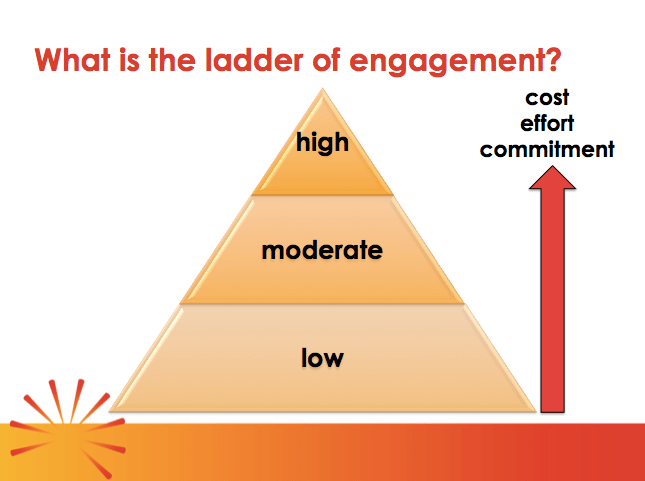Once members join, the next question becomes: How do you keep them? How do you
build real relationships over time that deepen your commitment to each other and lead to long-term loyalty on both sides?
The answer is ladders of engagement.
I’ve already talked a little bit about ladders of engagement in the membership 101 series, in that earlier instance, specifically related to joining an association. But they’re also the key to retention, which is critical to the health of your association.
According to ASAE’s Benchmarking in Association Management: Membership and Components Policies and Procedures, the average association invests $20,000 a year on recruitment and $15,000 on retention. That means associations feel the need to spend less in both absolute and relative terms, given the number of members retained versus recruited each year. It’s cheaper and easier to keep an existing member than to get a new one.
As I discussed in the earlier post, retention starts even before people join, and you have to teach your prospects and new members what it means to be a member, help them navigate what association offers and how it benefits them, and set expectations right from the start.
The overall goal is engagement: engaged members renew, disengaged members don’t.
Associations tend to have an inward-facing understanding of engagement: “How can we get our members to do what we want them to do?”
The thing is, that’s backwards. Better questions include:
- What do my members value?
- What reward system can I build around that?
Hopefully, the next logical question in the sequence has already occurred to you:
- How do I find out what my members value?
The answer is simple, but not necessarily easy: You ask them.
Remember: Asking people what they want is usually futile. To quote (possibly apocryphally) Henry Ford: “If I had asked people what they wanted, they would have said faster horses.”
Ask them, instead, what goals they’re trying to accomplish and what problems vex them.
People associate to accomplish things in a group that they can’t individually. That’s where you come in, helping them achieve goals or solve problems they can’t all by themselves.
When you know that, you can begin constructing ladders that focus on your members’ most important goals and most pressing problems. You’ll go through that same process of deepening effort, cost, and/or commitment that you did when converting a lead to membership, only with better insight into what to offer along the way.
Let’s say you discover that a young professional member wants to build her network.
You still start by offering something that’s, ideally, free (or included in the price of membership) that relates to that goal: say a networking brown bag lunch. Bonus points if there’s some sort of program, which doesn’t have to be terribly formal, that provides some content about how to build your network – tips like “Connecting on LinkedIn =/= building a professional network” or “Get to know people a little bit before asking for a job” or “Rather than flinging your cards at people like Mardi Gras throws, ask them for their cards.”
Assuming she attends, follow up by offering her something that involves a little more commitment, maybe a webinar that goes into more detail and maybe brings in an outside expert and thus costs something so you can pay said expert.
The next step might be to invite her to participate in your small group many-to-many less formal mentoring initiative.
The step after that might be to invite her to participate in your formal, structured one-on-one mentoring program.
When she finishes that formal program, you could ask her to present or write an article on her experiences for your association – or to be a greeter at your next brown bag, or to turn around and mentor someone herself, or join your task force that’s looking into technology mediated ways of extending your mentoring program to more people.
That’s one potential ladder. There are as many additional ladders as your members have goals and challenges.
When you flip your perspective from an internal focus on what the association wants to a member-centered way of viewing the world that puts the emphasis on helping people rather than pushing programs, products, and services, people will WANT to engage with you, because you’ll have become a vital partner in their success.





